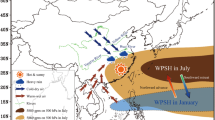Abstract
The two rice planthoppers that have caused devastating damage to rice crops in Peninsular Malaysia areNilaparvata lugens andSogatella furcifera. A surveillance system has been set up to monitor these pests. A case study in the off-season crop of 1980 in the Tanjung Karang Irrigation Scheme showed that hopperburn could be predicted a month before it happened. In the following main season, both surveillance records and ecological factors suggested that the pest would be under natural control and the forecast was accurate. The main factors considered in forecasting rice planthoppers were: migration, brachyptery, pest population, predatory: prey ratio, history of outbreaks and prevailing field conditions.
Similar content being viewed by others
References
DYCK, V.A., MISRA, B.C., ALAM, S., CHAN, C.N., HSIEH, C.Y. & REJESUS, R.S. (1979). Ecology of the brown planthopper in the Tropics.In: The Brown Planthopper Threat to Rice Production in Asia. Int. Rice Res. Inst., Los Banos: 61–98.
HEONG, K.L. (1977). Pest surveillance and monitoring system for rice cultivation in Tanjung Karang — a proposal. Rice Research Branch, MARDI, Malaysia, 19 pp. (mimeo).
HINCKLEY, A.D. (1963). Ecology and control of rice planthoppers in Fiji.Bull. ent. Res. 54: 467–481.
HIRAO, J. (1977). Forecasting brown planthopper outbreaks in Japan. Presented at Brown Planthopper Symposium, IRRI, Los Banos, Philippines.
HUBA, A. (1970). Biological backgrounds of pest forecasts and warnings.EPPO Public. Ser. A No. 57: 91–96.
LIM, G.S., HEONG, K.L. & OOi, A.C.P. (1978)a. The brown planthopper of rice in Malaysia. Kementerian Pertanian Malaysia, tech. Leafl. No. 15.
LIM, G.S., OOi, A.C.P. & KOH, A.K. (1978)b. Outbreak and control of the rice brown planthopper (Nilaparvata lugens Stal.) in Tanjung Karang, Malaysia.Proc. Pl. Prot. Conf. 1978. Ed. L.L. Aminet al.: 193–213.
LIM, G.S., HEONG, K.L. & OOi, A.C.P. (1980)a. Constraints to integrated pest control in Malaysia. Conference on Future Trends of integrated Pest Management, Bellagio, 1980. IOBC specal issue: 61–66.
LIM, G.S., OOL, A.C.P. & KOH, A.K. (1980b). Brown planthopper outbreaks and associated yield losses in Malaysia.IRRN 5 (1): 15–16.
MILLER, N.C.E. & PAGDEN, H.T. (1930). Preliminary observations onSogata spp. pests of padi.Malay. agric. J. 18: 238–241.
MOCHIDA, O. & DYCK, V.A. (1977). Bionomics of the brown planthopper,Nilaparvata lugens.In: The Rice Brown Planthopper. FFTC, ASPAC, Taipei, Taiwan: 192–198.
OOi, A.C.P. (1982). A surveillance system for rice planthoppers in Malaysia. International Conference on Plant Protection in the tropics, 1–4 March, 1982, Kuala Lumpur.
OOI, A.C.P., ABDUL RAHIM SALEH & YEOH, G.H. (1980). Outbreak of the whitebacked planthopper in the Muda Irrigation Scheme and its control.Malays. agric. J. 52: 315–331.
OTAKE, A. (1977). Natural enemies of the brown planthopper.In: The Rice Brown Planthopper, FFTC, ASPAC, Taipei, Taiwan: 42–57.
YUNUS, A. & HO, T.H. (1980). List of economic pests, host plants, parasites and predators in West Malaysia (1920–1978).Ministry of Agriculture, Malaysia, Bull. No. 153.
Author information
Authors and Affiliations
Rights and permissions
About this article
Cite this article
Ooi, P.A.C. Attempts at forecasting rice planthopper populations in Malaysia. Entomophaga 27 (Suppl 1), 89–98 (1982). https://doi.org/10.1007/BF02371859
Issue Date:
DOI: https://doi.org/10.1007/BF02371859




